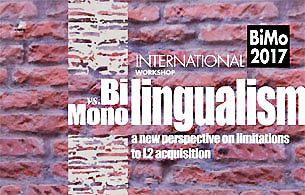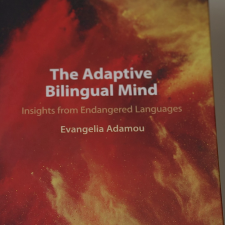Notice
Can French-English bilinguals process verb-particle constructions in a native-like manner? A self-paced reading study / Alexandre Herbay
- document 1 document 2 document 3
- niveau 1 niveau 2 niveau 3
Descriptif
Can French-English bilinguals process verb-particle constructions in a native-like manner? A self-paced reading study / Alexandre Herbay, in colloque "Bilingualism vs. monolingualism: a new perspective on limitations to L2 acquisition" organisé par la laboratoire Octogone-Lordat (Université Toulouse 2) sous la responsabilité de Barbara Köpke (UT2J), Holger Hopp (Technische Universität Braunschweig), Tanja Kupisch (Universität Konstanz), Université Toulouse Jean Jaurès, 19-20 juin 2017.
A central question inbilingualism is whether bilinguals are able to process their second language(L2) similarly to native speakers. Here, we focus on verb-particleconstructions (VPC) that are among the most difficult elements to acquire in L2English. The verb and the particle form a unit, which often has anon-compositional meaning (e.g. look up or chew out). Moreover, the particlecan be shifted after the direct object of the verb (e.g. The professor willlook the student’s last name up.).
Bilinguals can develop good implicitknowledge of the semantic properties of verb-particle constructions, asdemonstrated in a masked priming task (Blais & Gonnerman, 2013). On theother hand, their explicit knowledge (assessed via similarity judgments) isoften not as good as that of native speakers (Blais & Gonnerman, 2013). Ofparticular interest is the semantic and syntactic processing of these verbconstructions in a sentence context. Therefore, we sought to determine whetheror not bilingual reading time (RT) patterns would be similar to those observedfor native monolinguals (Gonnerman & Hayes, 2005). Thirty earlyFrench-English bilinguals were recruited. Their English language proficiencyand their explicit VPC semantic knowledge were assessed. During a self-pacedreading task, participants read 78 sentences with verb-particle constructionsthat followed the design used in Gonnerman & Hayes (2005) and that variedaccording to parameters that influence native speakers reading dynamics:verb-particle transparency (low, medium, or long), particle adjacency (shiftedor adjacent), and length of the object noun phrase (NP; 2, 3, or 5 words). RTshave been analyzed for NPs and particles. Overall, bilinguals’ RTs clearlyreflected the particle position, with higher RTs for sentences with shiftedparticles. A transparency effect was observed on the NP, with higher RTs forless transparent VPCs than for more transparent ones, while no such effect wasfound for particles. NPs and particles were read faster in sentences with shortNPs than in other ones.
The reading time effects and their interactions weremodulated strongly by participants’ English proficiency, with higherproficiency associated with shorter RTs. Examining participants’ explicitsemantic knowledge of VPCs, readers with more native-like knowledge of VPCs presentedRT patterns that looked more similar to those of monolinguals. Our behavioralresults are in line with bilingual processing of L2 that qualitativelyapproaches native-like online processing of structures that are absent in theL1, even if some quantitative differences remain.
Thème
Documentation
Bibliographie sélective
Blais, M.-J., & Gonnerman, L. M. (2013). Explicit and implicit semantic processing of verb–<br>particle constructions by French–English bilinguals. Bilingualism: Language and Cognition, 16(04), 829–846. [En ligne : http://doi.org/10.1017/S1366728912000673].
Gonnerman Laura M., & Hayes, C. R. (2005). The professor chewed the students ... out: Effects of dependency, length, and adjacency on word order preferences in sentences with verb particle constructions. Proceedings of the Twenty-Seventh Annual Conference of the Cognitive Science Society, 21–23.
Dans la même collection
-
On Qualitative Differences between Types of Language Acquisition / Jürgen Meisel
MeiselJürgen M.On Qualitative Differences between Types of Language Acquisition / Jürgen Meisel, in colloque "Bilingualism vs. monolingualism: a new perspective on limitations to L2 acquisition" organisé par le
-
Monolingual and multilingual learners of French. What are the effects of language background on spe…
BontempsMarieMonolingual and multilingual learners of French. What are the effects of language background on spelling? / Marie Bontemps
-
Attrition and (incomplete) acquisition of Italian answering strategies / Irene Caloi
Attrition and (incomplete) acquisition of Italian answering strategies / Irene Caloi, in colloque "Bilingualism vs. monolingualism: a new perspective on limitations to L2 acquisition" organisé par
-
Do temporarily induced code-switching modes alternate executive performance in late sequential bili…
Do temporarily induced code-switching modes alternate executive performance in late sequential bilinguals?
-
Processing variability in L2 learning: insights from articulatory training / Natalia Kartushina, Cl…
Processing variability in L2 learning: insights from articulatory training / Natalia Kartushina, Clara Martin
-
Age-related effects on language control and executive control: a behavioral-electrophysiological in…
MassaÉmilieAge-related effects on language control and executive control: a behavioral-electrophysiological investigation / Émilie Massa
-
Language, Development and the Bilingual Brain / Arturo E. Hernandez
HernandezArturo E.Language, Development and the Bilingual Brain / Arturo E. Hernandez, in colloque "Bilingualism vs. monolingualism: a new perspective on limitations to L2 acquisition" organisé par le laboratoire
-
Trilingual effects at the microstructure and macrostructure levels in children’s narratives / Mihae…
PirvulescuMihaelaTrilingual effects at the microstructure and macrostructure levels in children’s narratives / Mihaela Pirvulescu, in colloque "Bilingualism vs. monolingualism: a new perspective on limitations to L2
-
Language Processing in Bilinguals: Distinguishing Early Sequential from Simultaneous / Laura Sabour…
SabourinLauraLanguage Processing in Bilinguals: Distinguishing Early Sequential from Simultaneous / Laura Sabourin, Santa Vinerte, in colloque "Bilingualism vs. monolingualism: a new perspective on limitations to
-
Implicit causality as a predictive cue in child L1 and adult L2 processing of German: Evidence from…
Implicit causality as a predictive cue in child L1 and adult L2 processing of German: Evidence from visual-world eyetracking / Judith Schlenter
-
Cross-linguistic influence at the feature-level ? Evidence from Dutch-German bilingual preschoolers…
Cross-linguistic influence at the feature-level ? Evidence from Dutch-German bilingual preschoolers. How bilinguals are more monolingual-like than assumed / Antje Stoehr
-
Subject position in heritage Spanish in the Netherlands and the US: a case for cross-linguistic inf…
Subject position in heritage Spanish in the Netherlands and the US: a case for cross-linguistic influence / Brechje van Osch, in colloque "Bilingualism vs. monolingualism: a new perspective on
Sur le même thème
-
The Adaptive Bilingual Mind
AdamouEvangeliaLa chercheuse Evangelia Adamou (LACITO) présente son ouvrage "The Adaptive Bilingual Mind" (2021, Cambridge University Press).
-
On Qualitative Differences between Types of Language Acquisition / Jürgen Meisel
MeiselJürgen M.On Qualitative Differences between Types of Language Acquisition / Jürgen Meisel, in colloque "Bilingualism vs. monolingualism: a new perspective on limitations to L2 acquisition" organisé par le
-
Attrition and (incomplete) acquisition of Italian answering strategies / Irene Caloi
Attrition and (incomplete) acquisition of Italian answering strategies / Irene Caloi, in colloque "Bilingualism vs. monolingualism: a new perspective on limitations to L2 acquisition" organisé par
-
Do temporarily induced code-switching modes alternate executive performance in late sequential bili…
Do temporarily induced code-switching modes alternate executive performance in late sequential bilinguals?
-
Processing variability in L2 learning: insights from articulatory training / Natalia Kartushina, Cl…
Processing variability in L2 learning: insights from articulatory training / Natalia Kartushina, Clara Martin
-
Language, Development and the Bilingual Brain / Arturo E. Hernandez
HernandezArturo E.Language, Development and the Bilingual Brain / Arturo E. Hernandez, in colloque "Bilingualism vs. monolingualism: a new perspective on limitations to L2 acquisition" organisé par le laboratoire
-
Language Processing in Bilinguals: Distinguishing Early Sequential from Simultaneous / Laura Sabour…
SabourinLauraLanguage Processing in Bilinguals: Distinguishing Early Sequential from Simultaneous / Laura Sabourin, Santa Vinerte, in colloque "Bilingualism vs. monolingualism: a new perspective on limitations to
-
Implicit causality as a predictive cue in child L1 and adult L2 processing of German: Evidence from…
Implicit causality as a predictive cue in child L1 and adult L2 processing of German: Evidence from visual-world eyetracking / Judith Schlenter
-
Subject position in heritage Spanish in the Netherlands and the US: a case for cross-linguistic inf…
Subject position in heritage Spanish in the Netherlands and the US: a case for cross-linguistic influence / Brechje van Osch, in colloque "Bilingualism vs. monolingualism: a new perspective on
-
Transfer and derivational complexity in the wh-movement of heritage speakers and L2 learners: A bid…
Transfer and derivational complexity in the wh-movement of heritage speakers and L2 learners: A bidirectional study / Holger Hopp, in colloque "Bilingualism vs. monolingualism: a new perspective on
-
Bilinguismes et compliance phonique
JEP-TALN-RECITAL 2016 - Vendredi 8 juillet 2016 Session commune JEP/TALN 3 Bilinguismes et compliance phonique Marie Philippart de Foy, Véronique Delvaux, Kathy Huet, Myriam Piccaluga, Rima Rabeh and
-
Les catégories grammaticales dans la construction du bilinguisme
LauneyMichelLes catégories grammaticales dans la construction du bilinguisme (avec focus sur la catégorie de la personne















